三氯生(triclosan)是一种广谱抗菌剂, 广泛用于肥皂、牙膏、除臭剂等个人护理用品和生活用品中[1, 2].有研究表明, 三氯生会对一些水生物种或者哺乳动物造成内分泌干扰效应[3, 4]; 在光照以及氯消毒过程中, 三氯生会转化为一些毒性更高的二英以及氯化衍生物, 对生态系统和人体健康构成了潜在的危害[5, 6].由于传统的污水处理工艺对三氯生的去除效果有限, 三氯生可通过市政废水的排放进入环境.世界各地的地表水和地下水中都检测到了三氯生, 浓度从ng·L-1到μg·L-1不等[7~9].目前, 可有效去除三氯生的技术主要有芬顿[10], 臭氧(O3)氧化[11]和光催化氧化[12]等.其中芬顿氧化受pH影响较大, 仅在酸性条件下效果较好[10]; 三氯生虽然可以有效地被O3方法降解[11], 但O3不适合在地下水修复的场景下使用.
近年来, 基于硫酸根自由基(SO4·-)的高级氧化技术广泛应用于土壤和地下水污染修复[13]. SO4·-具有较高的氧化还原电位(E0=2.5~3.1 V), 和羟基HO·的电位相当(E0=1.8~2.7 V), 但SO4·-降解有机污染物时受pH的影响小, 有利于在近中性的条件中使用[14~16]. SO4·-可以通过加热[17]、紫外光[18]和过渡金属催化[19, 20]等方法活化过硫酸盐(S2O82-)产生.其中紫外光活化的方法安全无毒, 不会造成二次污染, 但是紫外光的产生成本比较高, 在土壤和地下水修复的应用中会受到限制.而过渡金属催化对pH有一定的选择性, 当反应pH较高时, 过渡金属容易形成沉淀, 影响活化效率, 同时也可能造成二次污染.热活化虽然需要消耗能量, 但受pH影响较小.

|
(1) |

|
(2) |
因此, 本研究采用热活化过硫酸盐降解水中的三氯生, 考察了温度、过硫酸盐浓度以及水中溶解的天然有机质、氯离子(Cl-)和溴离子(Br-)对三氯生降解的影响, 同时对中间产物进行分析, 探讨了三氯生的降解机制, 以期为评价基于SO4·-的高级氧化技术去除水中三氯生的应用可行性提供依据.
1 材料与方法 1.1 试剂过硫酸钠(Na2S2O8)、三氯生(98%)和腐殖酸(HA)均购自Aldrich公司(中国上海), 乙腈、甲醇和乙酸均为色谱纯, 购自TEDIA(Fairfield).研究中使用的其他试剂, 如氯化钠(NaCl)等均为分析纯以上级别.用去离子水配制浓度为100 mmol·L-1的过硫酸钠溶液、10.0 mg·L-1的三氯生母液和100.0 mg·L-1的HA母液, 置于冰箱保存, 反应溶液由储备液加去离子水稀释得到.其中, HA储备液的总有机碳(TOC)含量用耶拿multi N/C 3100 TOC仪测定.
1.2 实验方法所有反应均在42 mL EPA瓶中进行.三氯生的初始浓度为1.0 mg·L-1, 加入10 mmol·L-1磷酸盐缓冲液调节溶液pH至7.0.将反应瓶置于恒温水浴锅中, 预热后加入过硫酸盐开始反应.每隔10 min, 取0.8 mL反应液, 迅速和0.2 mL的甲醇混合以终止反应, 用高效液相色谱(HPLC)分析样品中三氯生的剩余浓度.在上述的反应体系中, 分别考察温度(40、45、50、55℃), 过硫酸盐的浓度(0.5、1.0、2.0、3.0、4.0 mmol·L-1), HA浓度(2.0、4.0、6.0、8.0 mg·L-1), Cl-浓度(5、10、20 μmol·L-1)和Br-浓度(5、10、20 μmol·L-1)对三氯生降解的影响.所有样品在HPLC分析前均置于4℃冰箱保存.
1.3 三氯生的定量分析样品中三氯生的浓度用日立(Hitachi)L-2000型HPLC进行分析.具体条件为:C18反相色谱柱(Hitachi LaChrom, 5 μm×4.6 mm×125 mm); 流动相为水与0.1%乙酸和乙腈与0.1%乙酸(体积比20:80), 流速为1.0 mL·min-1; 进样量为40 μL; 采用二极管阵列检测器(DAD), 定量波长为224 nm.
1.4 中间产物的鉴定将3份50 mL反应液置于50℃恒温水浴锅中, 其中三氯生的初始浓度为1.0 mg·L-1, 过硫酸钠浓度为1.0 mmol·L-1, pH为7.0.反应30、60和90 min后分别取出反应液置于冰浴中以终止反应.样品混合后使用Waters Oasis HLB柱(WAT106202)进行固相萃取, 富集后的样品通过配备有电喷雾离子化接口(ESI)的Agilent 6410三重四极杆质谱仪(MS)分析.仪器设为负离子和全扫描(50~500 m/z)模式, 具体参数为:毛细管电压-3.5 kV; 碎裂电压135 V; 氮气(≥ 99.995%)作干燥气, 流速10 L·min-1; 温度350℃; 喷雾器压力40 psi(280 kPa).
2 结果与讨论 2.1 温度的影响设置三氯生初始浓度为1.0 mg·L-1, 过硫酸钠浓度为1.0 mmol·L-1, 当反应温度为50℃时, 60 min内三氯生的降解率达到71%, 这表明三氯生可以有效地被降解.改变温度能够影响过硫酸盐的分解效率, 从而改变反应液中SO4·-的平衡浓度[21, 22].因此, 研究考察了不同反应温度(40、45、50和55℃)对过硫酸盐降解三氯生的影响.结果如图 1(a)所示, 当温度从40℃升高至55℃时, 30 min内三氯生的降解率由13%升高至80%, 这表明提高反应温度会加快三氯生的降解.温度的升高会导致活化生成的SO4·-增加; 而且, 根据一般化学反应规律, 反应速率常数也随温度的升高而变大, 因此温度的升高会显著加快三氯生的降解.在不同反应温度下, 三氯生的降解曲线均可以用一级反应动力学方程拟合:

|
(3) |
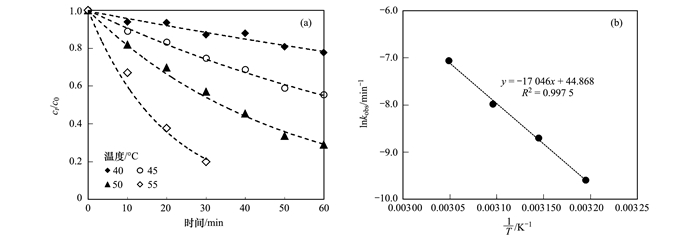
|
图 1 温度对过硫酸盐降解三氯生的影响 Fig. 1 Effects of temperature on the degradation of triclosan by persulfate |
式中, c0为三氯生的初始浓度(mg·L-1), ct为在t时, 反应液中剩余的三氯生浓度(mg·L-1), kobs为表观一级反应动力学常数(min-1), 其数值可通过拟合实验数据得到. kobs与反应温度的关系符合阿伦尼乌斯方程(Arrhenius equation):

|
(4) |
其中, A是指前因子(min-1); Ea是活化能(kJ·mol-1); R是摩尔气体常量(8.314 J·mol-1·K-1); T是绝对温度(K).如图 1(b)所示, 线性拟合lnkobs与1/T, 由斜率得知热活化过硫酸盐降解三氯生反应的表观活化能为142 kJ·mol-1.
2.2 过硫酸盐浓度的影响如图 2(a)所示, 增加过硫酸钠的初始浓度, 三氯生降解明显加快.过硫酸钠浓度为0.5 mmol·L-1时, 60 min内三氯生的降解率为28.5%;而当过硫酸钠浓度为2.0 mmol·L-1时, 反应60 min, 降解率达到73.5%.在反应液中, 过硫酸钠的初始浓度越高, 活化产生的自由基就越多[23~25], 三氯生的降解就越快.在不同过硫酸钠浓度下, 三氯生的降解也都符合一级反应动力学规律, 其表观反应动力学常数kobs可通过拟合实验数据得到.由图 2(b)可知, 增加过硫酸钠浓度, kobs也随之增大, 且与过硫酸钠的浓度呈正比.
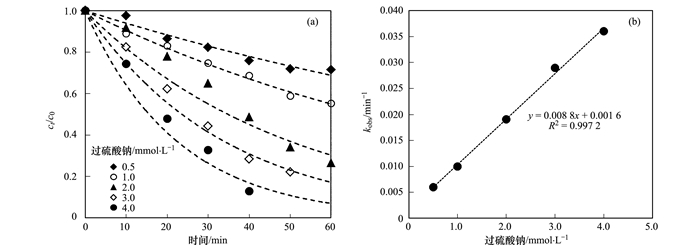
|
反应条件:[三氯生]0=1.0 mg·L-1; T=45℃; pH=7.0; t=60 min 图 2 过硫酸盐浓度对热活化过硫酸盐降解三氯生的影响 Fig. 2 Effects of persulfate concentration on the degradation of triclosan by heat activated persulfate |
自然水体中广泛存在着天然有机质, 研究发现它们会对SO4·-降解有机污染物产生影响[23, 24].实验选择以HA模拟水体中的天然有机质, 如图 3所示, HA对三氯生的降解产生了明显的抑制作用, 并随着加入浓度的升高, 抑制程度也随之增加.不加HA的情况下, 反应60 min时三氯生的降解率是71%, 而加入2.0 mg·L-1 HA(以TOC计)后, 三氯生的降解率降低到了26%;当加入的HA浓度为4.0 mg·L-1时, 三氯生的降解率就降低到了15%. HA分子中含有羟基和胺基等基团, 它们是富含电子的活性基团, 很容易和一些亲电试剂(SO4·-和·OH)反应[26, 27].因此, 反应液中存在的HA会和三氯生竞争自由基, 导致三氯生的降解受到抑制.而随着HA浓度的增加, 竞争作用越明显, 三氯生降解受到的抑制就越强.
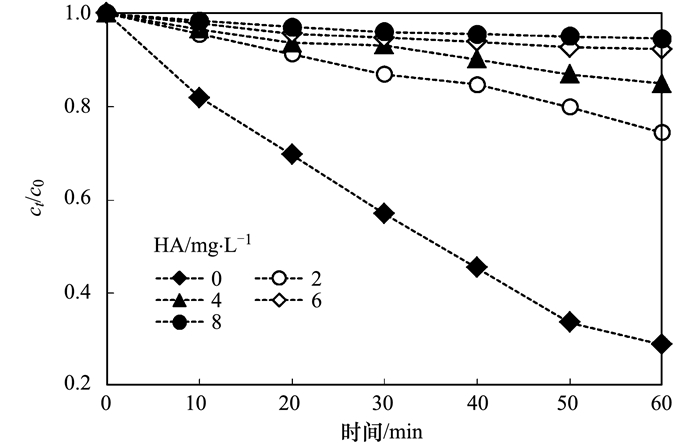
|
反应条件:[三氯生]0=1.0 mg·L-1; [过硫酸钠]0=1.0 mmol·L-1; T=50℃; t=60 min 图 3 腐殖酸对热活化过硫酸盐降解三氯生的影响 Fig. 3 Effects of HA on the degradation of triclosan by heat activated persulfate |
在基于SO4·-的高级氧化体系中, 卤素离子可以被氧化为一系列具有活性的卤素物质[28, 29], 它们可能对三氯生的降解产生影响.由图 4可知, 当溶液中含有5 μmol·L-1的Cl-时, 三氯生的降解受到了轻微的促进; 但是当Cl-浓度增加至10 μmol·L-1甚至更高时, 三氯生的降解反而受到了抑制.如反应式(5)~(6), SO4·-首先可以与Cl-反应生成氯自由基(Cl·)(E0=2.41 V), 而生成的Cl-可以继续和Cl-反应生成Cl2·-(E0=1.36 V).这些生成的氯自由基(Cl·和Cl2·-)都具有一定的氧化能力, 可以与富含电子的化合物(比如酚类)发生反应, 生成氯化化合物[20].因此当Cl·浓度较低时, Cl·虽然和三氯生竞争了反应液中的SO4·-, 但生成的Cl·会参与三氯生的降解, 抵消了SO4·-的清除, 三氯生的降解反而受到了轻微的促进; 但是随着Cl·浓度的增加, 消耗的SO4·-也随之增加, 而生成的Cl·又进一步转化为氧化能力相对较弱的Cl2·-, 从而导致三氯生的降解速率降低.

|
(5) |

|
(6) |
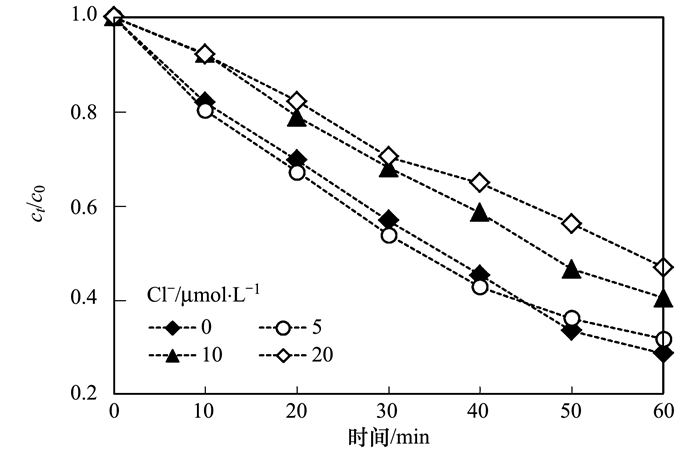
|
反应条件:[三氯生]0=1.0 mg·L-1; [过硫酸钠]0=1.0 mmol·L-1; T=50℃; t=60 min 图 4 氯离子对热活化过硫酸盐降解三氯生的影响 Fig. 4 Effects of Cl- on the degradation of triclosan by heat activated persulfate |
如图 5所示, Br-的加入也会抑制三氯生的降解, 且抑制程度随着Br-浓度的增加而增强.当Br-浓度为20 μmol·L-1时, 反应60 min时三氯生的降解率只有47%, 而没有Br-时三氯生的降解率却是71%.这可能是因为Br-会与三氯生竞争反应液中的SO4·-生成Br·, 但是Br·的氧化能力(E0=1.36 V)相对较弱[30], 从而造成了三氯生降解速率降低.
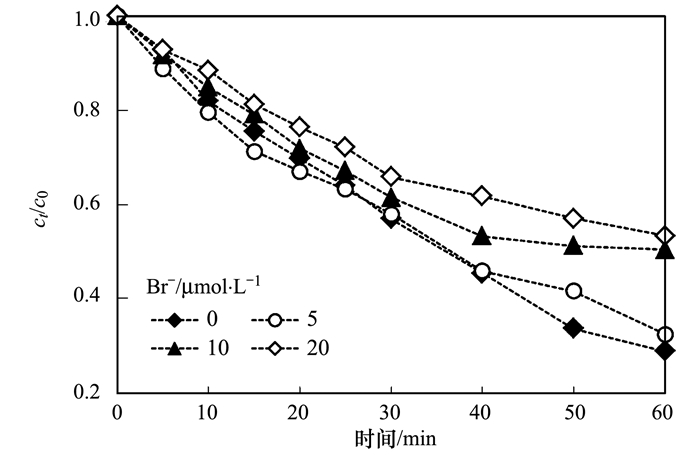
|
反应条件:[三氯生]0=1.0 mg·L-1; [过硫酸钠]0=1.0 mmol·L-1; T=50℃; t=60 min 图 5 溴离子对热活化过硫酸盐降解三氯生的影响 Fig. 5 Effects of Br- on the degradation of triclosan by heat activated persulfate |
利用MS对热活化过硫酸盐降解三氯生过程中的产物进行了分析, 如图 6所示.由于三氯生分子含有3个氯原子, 在MS上很容易根据氯元素的特征同位素指纹判断和它有关的产物, 同时确定产物分子中含有的氯原子个数, 然后结合产物峰的m/z推测对应的分子式. MS图中除了残留三氯生的峰簇(m/z 287/289/291/293), 还出现了6个含氯元素的峰簇.其中m/z 161/163/165对应的M:(M+2):(M+4)接近9:6:1, 推测该物质含有2个氯原子, 分子式为C6H4OCl2, 经对比标准样品确定该产物是2, 4-二氯苯酚; m/z 143/145对应物质的特征吸收峰簇比例为3:1, 说明该产物含有1个氯原子, 推测分子式为C6H5O2Cl; 而m/z 317/319/321/323、m/z 333/335/337/339、m/z 349/351/353/355、m/z 383/385/387/389对应物质的特征吸收峰簇比例都为27:27:9:1, 说明分子中都含有3个氯原子, 根据分子量判断, 它们很可能是三氯生的氧化、羟基化产物.结合以上分析, 推测三氯生可能的降解途径有2条, 如图 7所示.第一条途径是醚键断裂, 由SO4·-直接进攻三氯生分子中的醚键, 使之断裂, 生成2, 4-二氯苯酚(m/z 161/163/165)和4-氯-邻苯二酚(m/z 143/145);第二条降解途径是酚环羟基化, SO4·-是亲电物质, 可通过电子转移使三氯生形成阳离子自由基, 该物质很不稳定, 可以和H2O进一步结合转化为羟基化的三氯生, 由于SO4·-的强氧化性, 羟基化的三氯生又会被氧化成醌类的中间体, 而产物m/z 317/319/321/323、m/z 333/335/337/339、m/z 349/351/353/355、m/z 383/385/387/389分子中都含有3个氯原子, 且分子质量和这种醌类的中间体分别相差16、32、64和82, 结合羟基的定向作用和氯原子的空间阻碍作用, 推测这4种产物分别为2-氯-5-(2, 4-二氯-6-羟基苯氧基)-1, 4-苯醌、2-氯-5-(2, 4-二氯-5, 6-二羟基苯氧基)-1, 4-苯醌、2-氯-5-(2, 4-二氯-3, 5, 6-三羟基苯氧基)-1, 4-苯醌[12, 31]和六羟基化的三氯生.
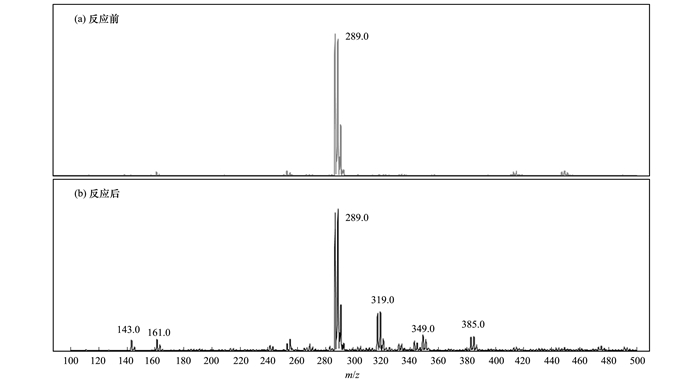
|
反应条件:[三氯生]0=1.0 mg·L-1; [过硫酸钠]0=1.0 mmol·L-1; T=50℃ 图 6 热活化过硫酸盐降解三氯生的中间产物的质谱 Fig. 6 MS of the transformation products of triclosan produced by heat activated persulfate oxidation |

|
图 7 热活化过硫酸盐降解三氯生的反应途径 Fig. 7 Proposed transformation pathways for triclosan degradation by heat activated persulfate oxidation |
热活化过硫酸盐可有效降解水中的三氯生, 降解符合一级反应动力学规律, 表观活化能为142 kJ·mol-1.增加过硫酸盐的浓度, 可提高三氯生的降解速率, 且反应速率常数和过硫酸盐的浓度呈正比.三氯生的降解受到HA、Cl-和Br-的影响.其中, Cl-对反应的影响比较复杂, 低浓度的Cl-会促进三氯生的降解, 而高浓度的Cl-却会抑制反应的进行. HA和Br-则都对反应有抑制作用.三氯生的降解主要从醚键的断裂和酚环羟基化开始, 通过MS分析, 检测到了4-氯-邻苯二酚、2, 4-二氯苯酚和2-氯-5-(2, 4-二氯-6-羟基苯氧基)-1, 4-苯醌等中间产物.
| [1] | Schweizer H P. Triclosan:a widely used biocide and its link to antibiotics[J]. FEMS Microbiology Letters, 2001, 202(1): 1-7. DOI:10.1111/fml.2001.202.issue-1 |
| [2] | Hua W Y, Bennett E R, Letcher R J. Triclosan in waste and surface waters from the upper Detroit River by liquid chromatography-electrospray-tandem quadrupole mass spectrometry[J]. Environment International, 2005, 31(5): 621-630. DOI:10.1016/j.envint.2004.10.019 |
| [3] | Fair P A, Lee H B, Adams J, et al. Occurrence of triclosan in plasma of wild Atlantic bottlenose dolphins (Tursiops truncatus) and in their environment[J]. Environmental Pollution, 2009, 157(8-9): 2248-2254. DOI:10.1016/j.envpol.2009.04.002 |
| [4] | Tatarazako N, Ishibashi H, Teshima K, et al. Effects of triclosan on various aquatic organisms[J]. Environmental Sciences:An International Journal of Environmental Physiology and Toxicology, 2004, 11(2): 133-140. |
| [5] | Buth J M, Steen P O, Sueper C, et al. Dioxin photoproducts of triclosan and its chlorinated derivatives in sediment cores[J]. Environmental Science & Technology, 2010, 44(12): 4545-4551. |
| [6] |
徐海丽, 林毅, 孙倩, 等. 三氯生的生态效应及其在环境中的迁移转化[J]. 生态毒理学报, 2012, 7(3): 225-233. Xu H L, Lin Y, Sun Q, et al. Ecological effects of triclosan and its transport and transformation in the environment[J]. Asian Journal of Ecotoxicology, 2012, 7(3): 225-233. |
| [7] | Singer H, Müller S, Tixier C, et al. Triclosan:?Occurrence and fate of a widely used biocide in the aquatic environment:field measurements in wastewater treatment plants, surface waters, and lake sediments[J]. Environmental Science & Technology, 2002, 36(23): 4998-5004. |
| [8] | McAvoy D C, Schatowitz B, Jacob M, et al. Measurement of triclosan in wastewater treatment systems[J]. Environmental Toxicology and Chemistry, 2002, 21(7): 1323-1329. DOI:10.1002/etc.v21:7 |
| [9] | Zhao J L, Ying G G, Liu Y S, et al. Occurrence and risks of triclosan and triclocarban in the Pearl River system, South China:from source to the receiving environment[J]. Journal of Hazardous Materials, 2010, 179(1-3): 215-222. DOI:10.1016/j.jhazmat.2010.02.082 |
| [10] | Yang B, Ying G G, Zhao J L, et al. Oxidation of triclosan by ferrate:reaction kinetics, products identification and toxicity evaluation[J]. Journal of Hazardous Materials, 2011, 186(1): 227-235. DOI:10.1016/j.jhazmat.2010.10.106 |
| [11] | Suarez S, Dodd M C, Omil F, et al. Kinetics of triclosan oxidation by aqueous ozone and consequent loss of antibacterial activity:relevance to municipal wastewater ozonation[J]. Water Research, 2007, 41(12): 2481-2490. DOI:10.1016/j.watres.2007.02.049 |
| [12] | Rafqah S, Wong-Wah-Chung P, Nelieu S, et al. Phototransformation of triclosan in the presence of TiO2 in aqueous suspension:mechanistic approach[J]. Applied Catalysis B:Environmental, 2006, 66(1-2): 119-125. DOI:10.1016/j.apcatb.2006.03.004 |
| [13] | Zhang B T, Zhang Y, Teng Y G, et al. Sulfate radical and its application in decontamination technologies[J]. Critical Reviews in Environmental Science and Technology, 2015, 45(16): 1756-1800. DOI:10.1080/10643389.2014.970681 |
| [14] | Wardman P. Reduction potentials of one-electron couples involving free radicals in aqueous solution[J]. Journal of Physical and Chemical Reference Data, 1989, 18(4): 1637-1755. DOI:10.1063/1.555843 |
| [15] | Anipsitakis G P, Dionysiou D D. Degradation of organic contaminants in water with sulfate radicals generated by the conjunction of peroxymonosulfate with cobalt[J]. Environmental Science & Technology, 2003, 37(20): 4790-4797. |
| [16] | Lin C J, Pehkonen S O. The chemistry of atmospheric mercury:a review[J]. Atmospheric Environment, 1999, 33(13): 2067-2079. DOI:10.1016/S1352-2310(98)00387-2 |
| [17] |
赵进英, 张耀斌, 全燮, 等. 加热和亚铁离子活化过硫酸钠氧化降解4-CP的研究[J]. 环境科学, 2010, 31(5): 1233-1238. Zhao J Y, Zhang Y B, Quan X, et al. Sodium peroxydisulfate activation by heat and Fe(Ⅱ) for the degradation of 4-CP[J]. Environmental Science, 2010, 31(5): 1233-1238. |
| [18] | Fang J Y, Shang C. Bromate formation from bromide oxidation by the UV/persulfate process[J]. Environmental Science & Technology, 2012, 46(16): 8976-8983. |
| [19] | Wu J, Zhang H, Qiu J J. Degradation of acid orange 7 in aqueous solution by a novel electro/Fe2+/peroxydisulfate process[J]. Journal of Hazardous Materials, 2012, 215-216: 138-145. DOI:10.1016/j.jhazmat.2012.02.047 |
| [20] | Anipsitakis G P, Dionysiou D D, Gonzalez M A. Cobalt-mediated activation of peroxymonosulfate and sulfate radical attack on phenolic compounds. Implications of chloride ions[J]. Environmental Science & Technology, 2006, 40(3): 1000-1007. |
| [21] | Tsitonaki A, Petri B, Crimi M, et al. In situ chemical oxidation of contaminated soil and groundwater using persulfate:a review[J]. Critical Reviews in Environmental Science and Technology, 2010, 40(1): 55-91. DOI:10.1080/10643380802039303 |
| [22] | Gu X G, Lu S G, Li L, et al. Oxidation of 1, 1, 1-trichloroethane stimulated by thermally activated persulfate[J]. Industrial & Engineering Chemistry Research, 2011, 50(19): 11029-11036. |
| [23] | Ji Y F, Dong C X, Kong D Y, et al. Heat-activated persulfate oxidation of atrazine:implications for remediation of groundwater contaminated by herbicides[J]. Chemical Engineering Journal, 2015, 263: 45-54. DOI:10.1016/j.cej.2014.10.097 |
| [24] | Nie M H, Yang Y, Zhang Z J, et al. Degradation of chloramphenicol by thermally activated persulfate in aqueous solution[J]. Chemical Engineering Journal, 2014, 246: 373-382. DOI:10.1016/j.cej.2014.02.047 |
| [25] |
廖云燕, 刘国强, 赵力, 等. 利用热活化过硫酸盐技术去除阿特拉津[J]. 环境科学学报, 2014, 34(4): 931-937. Liao Y Y, Liu G Q, Zhao L, et al. Removal of atrazine in heat activated persulfate oxidation process[J]. Acta Scientiae Circumstantiae, 2014, 34(4): 931-937. |
| [26] | Westerhoff P, Mezyk S P, Cooper W J, et al. Electron pulse radiolysis determination of hydroxyl radical rate constants with Suwannee River fulvic acid and other dissolved organic matter isolates[J]. Environmental Science & Technology, 2007, 41(13): 4640-4646. |
| [27] | Gara P M D, Bosio G N, Gonzalez M C, et al. A combined theoretical and experimental study on the oxidation of fulvic acid by the sulfate radical anion[J]. Photochemical & Photobiological Sciences, 2009, 8(7): 992-997. |
| [28] | Liang C J, Wang Z S, Mohanty N. Influences of carbonate and chloride ions on persulfate oxidation of trichloroethylene at 20℃[J]. Science of the Total Environment, 2006, 370(2-3): 271-277. DOI:10.1016/j.scitotenv.2006.08.028 |
| [29] | Yang Y, Pignatello J J, Ma J, et al. Comparison of halide impacts on the efficiency of contaminant degradation by sulfate and hydroxyl radical-based advanced oxidation processes (AOPs)[J]. Environmental Science & Technology, 2014, 48(4): 2344-2351. |
| [30] | Lutze H V, Bakkour R, Kerlin N, et al. Formation of bromate in sulfate radical based oxidation:Mechanistic aspects and suppression by dissolved organic matter[J]. Water Research, 2014, 53: 370-377. DOI:10.1016/j.watres.2014.01.001 |
| [31] | Song Z, Wang N, Zhu L H, et al. Efficient oxidative degradation of triclosan by using an enhanced Fenton-like process[J]. Chemical Engineering Journal, 2012, 198-199: 379-387. DOI:10.1016/j.cej.2012.05.067 |
 2018, Vol. 39
2018, Vol. 39


